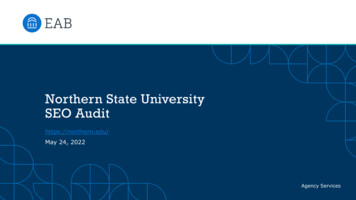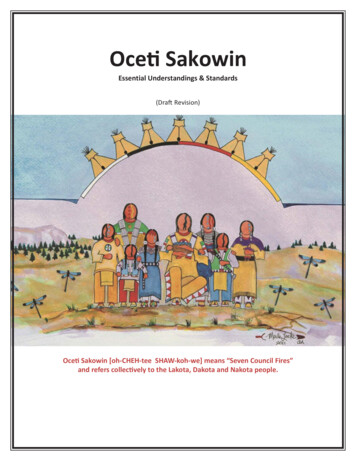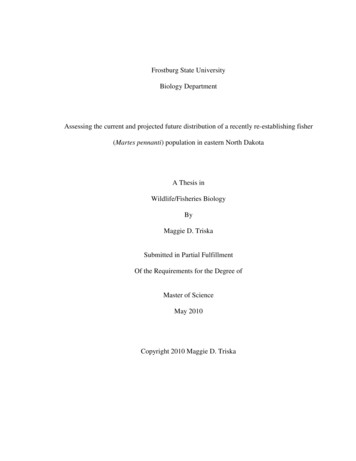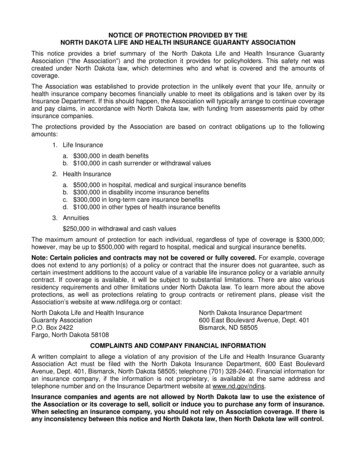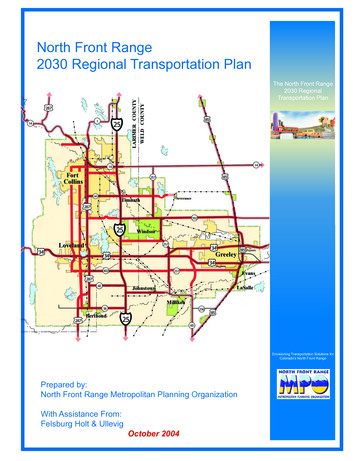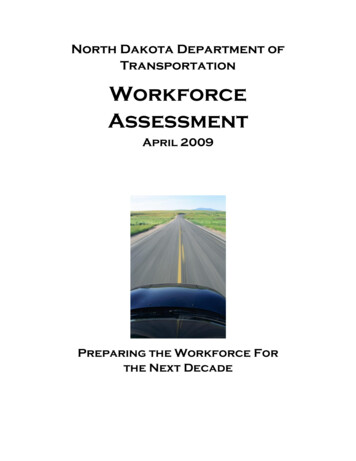
Transcription
North Dakota Department ofTransportationWorkforceAssessmentApril 2009Preparing the Workforce Forthe Next Decade
Assessment prepared byUniversity of Mary Management 700 Seminar ClassJanuary – April 2009Seminar MembersArndorfer, SethBesmer, ScottBoese, DykeDallman, TomDunbar, LynetteEllefson, ShawnEmineth, LaDonnaFettig, BrianFinkbeiner, LaceyGoodmanson, TrampasHaman, AmberJohnson, SteveKeator, GailLakoduk-Emst, Stacie LeeLowe, BarbaraRoerick, DarylSandy, BlairSchmitz, JanelZimmerman, MaryThe University of Mary Management 700 Seminar wishes to thank the following for theirassistance in preparing this report.Ken Heitkamp and NDDOT Human Resource staff membersClark Johnson, Associate Graduate Faculty
Table of ContentsI.II.III.IV.V.VI.Executive SummaryGoal 4.1: Employee recruitment and retention programa. Approachb. Workforce Assessmentc. Comparative Researchd. Recommendations: Workforce Assessmente. Recommendations: Otherf. References CitedGoal 4.2: Professional growth and development programsa. Approachb. Workforce Assessmentc. Comparative Researchd. Recommendations: Workforce Assessmente. Recommendations: Otherf. References CitedGoal 4.3: Health and Wellness Programsa. Approachb. Workforce Assessmentc. Comparative Researchd. Recommendations: Workforce Assessmente. Recommendations: Otherf. References CitedGoal 4.4: Workforce Assessment PlanAppendixa. Goal 4.1 Supporting Documentationb. Goal 4.2 Supporting Documentationc. Goal 4.3 Supporting Documentationd. Goal 4.4 Supporting DocumentationPage 1Page 2Page 2Page 2Page 6Page 14Page 14Page 16Page 17Page 17Page 17Page 24Page 25Page 26Page 27Page 28Page 28Page 28Page 39Page 42Page 43Page 45page 46Page 54Page 66Page 70Page 90
Executive SummaryThe seminar team reviewed the Employee Goals established in the 2008-2013 NorthDakota Department of Transportation (NDDOT) Strategic Plan. The Employee Goal is to“enhance employee recruitment, development, and well being.” (2008-2013 North DakotaDepartment of Transportation Strategic Plan). In pursuit of this goal, the NDDOT has identifiedfive key objectives.Objective 4.1: Develop an ongoing employee recruitment and retention program.Objective 4.2: Develop ongoing professional growth and development programs foremployees and emphasizing quality products and services.Objective 4.3: Review and enhance health and wellness programs.Objective 4.4: Develop and implement a Workforce Assessment plan.Objective 4.5: Continue to improve work facilities.The team was asked to review Objectives 4.1 – 4.4, with special emphasis on objective4.4. Each objective includes specific recommendations for the objective. Objectives 4.1, 4.2, and4.3 each have recommendations related to achieving Objective 4.4, and those are detailed in theindividual sections, as well as under Objective 4.4.In 2006, the State Auditor‟s Office released a Workforce Assessment Plan geared towardstate agencies in Texas in its assessment of future needs. This is the foundation forrecommendations for Objective 4.4.Two activities should begin immediately in order to complete a Workforce AssessmentPlan by 2013.1. Establish the vision for the NDDOT of 2013. While objectives are in place, the thoughtprocess addressing types of employees required, education level, and the impact oftechnology needs to be defined. Additionally, workforce realities such as addressing theincrease of ethnicity should be included in this vision. This vision of NDDOT of 2013must be complete in order to identify the gaps that must be addressed in the next 3-1/2years.2. Consistent data collection is necessary in order to accurately assess the status of theworkforce. Research found numerous areas that could benefit from structured evaluationprograms. The team recommends that one year of consistent data collection be completedso objective data may be utilized in tandem with the subjective employee surveycompleted every two years in determining the current status of employees. An accuratepicture of the current workforce situation is required in order to complete the next stepwhich is to identify the gaps in knowledge, skills, and abilities for a prepared NDDOT in2013.1
Objective 4.1 “Develop an ongoing employee recruitment and retention program”(2008-2013 North Dakota Department of Transportation Strategic Plan).ApproachData available from the NDDOT was assessed. A NDDOT employee primarilyresponsible with recruiting participated in face-to-face interviews with two team members.Other entities were interviewed and policies reviewed in an effort to draw comparisons inthe comparative research portion of this analysis. This analysis consists of external demographicinformation that impacts the recruitment and retention of employees, wage comparisons, andsummaries of external interviews from four local private firms that employ staff with similar jobtitles and job duties.Workforce AssessmentThis workforce assessment consists of NDDOT demographic information based onlocation, age, and turnover. This analysis summarizes benefits available to employees, aninterview with a NDDOT employee primarily responsible for recruiting and elements of the2008 employee satisfaction survey as related to recruitment and retention.At the time of this report, there are 1,011 regular employees within the NDDOT, and theyare located in eight locations. Bismarck has 545 (54 percent), Devils Lake has 72 (sevenpercent), Dickinson has 57 (six percent), Fargo has 84 (eight percent), Grand Forks has 72 (sevenpercent), Minot has 63 (six percent), Valley City has 71 (seven percent), and Williston has 47(five percent). Seven of these employees are part-time, with the balance employed full-time. Notincluded in these numbers are seasonal workers, interns, and temporary contracted employees.(Employee wage and demographic report provided by NDDOT HR Employee, February 15,2009)There are currently four generations of workers within the NDDOT. The “Warbaby” or“Traditionalists” consist of those employees born between 1920 and 1945 or ages 64-89. “BabyBoomers” are employees born between 1946 and 1959 or ages 50-63. “Generation X” areemployees born between 1960 and 1979 or ages 30-49. “Generation Y” are the youngestemployees, born between 1980 and 1999 and are under 30 years old. The average age is 47years, with 72 percent of the workforce being over 41 years of age. Of these 1,011 employees,255 will reach or have reached the retirement rule of 85 within the next three years. Thisconstitutes 25 percent of the workforce (NDDOT Employee Demographics, January 9, 2009).Approximately 25 percent of the workforce is female, however only 18.5 percent of theworkers under 40 are female. This indicates an under representation of females within theNDDOT. Also under represented are Native Americans, as this group comprises only 1.62
percent of the NDDOT workforce while they comprise 5 percent of North Dakota‟s /)Turnover percentages within the NDDOT are relatively low in comparison to the fouragencies interviewed for comparative research. In 2008, 87 employees left the organizationyielding an eight percent turnover rate. Of these, 29 retired, indicating a non-retirement orpreventable turnover rate of 5.7 percent. The lowest percentage of employees leaving theorganization was in the 41-50 age groups with a turnover rate of four percent. The highestpercentage was in the 31-40 year age bracket with a turnover rate of 14 percent. This isconcerning as these employees are considered mid-career and in the lower edge of Generation X.Of those who left the organization prior to retirement, the most common reason given was“Other employment including transferring to another state agency” (2008 NDDOT Survey ofOrganizational Health).BenefitsUpon hire, all regular full-time employees receive standard North Dakota State benefitswhich includes family medical insurance, life insurance, 401K, 10 paid holidays, 12 daysvacation annually, 12 days sick time annually, Employee Assistance Program (EAP), andflexible spending. In addition to these benefits, NDDOT also offers:Approved overtime/comp timeApproved overtime/comp time is paid to regular and probationary employees whowork in excess of 40 hours per week. Employees can take overtime in cash, paid attime-and-a-half per hour of overtime worked, or as comp time, awarded at 1- ½hours for every hour of overtime worked.FlextimeFlextime is an alternate work schedule approved by an employee's supervisor,division director, or district engineer. Employees may work an alternative flexschedule if service to the public remains available during normal working hoursMonday through Friday. Alternative schedules to the eight-hour standard workdayare either four 10-hour days with schedule starting on Monday or Tuesday andending no later than Friday, or four nine-hour days with one four-hour day.Training and professional developmentTraining and professional development are offered to regular and probationaryemployees. Programs include in-house training, as well as specialized training3
provided by institutions, companies, and agencies. Generally, registration fees andexpenses are paid by NDDOT.Training LibraryThe training library offers employees an extensive collection of books, tapes, andvideos on personal and professional development.Tuition reimbursementTuition reimbursement up to 10,000 per employee is available to regular andprobationary employees who attend pre-approved undergraduate, graduate, ortechnical training courses. Recently, the NDDOT developed a partnership with theNorth Dakota State College of Science (NDSCS) to offer current NDDOTemployees the opportunity to earn their Civil Engineering degree without leavingthe department and with limited travel to the Wahpeton campus. NDDOT will alsomake some district offices available for training sites.ScholarshipsScholarships are offered to students in engineering, engineering technology, andother related technology fields. Eligible students may receive up to 2,000 perschool year and up to 6,000 total, with an expectation of summer and aftergraduation employment.Sign-on or retention bonusThese bonuses are offered to certain eligible positions, including engineering,engineering related, and some information technology positions. The employeemust commit to two years of employment, or reimburse the amount of bonusattributable to the incomplete tings.htm#nddotbenefits, retrieved March 7, 2009).An interview conducted with a NDDOT employee who is primarily responsible forrecruiting revealed four main areas for recruitment:Professional candidates with four-year degrees, focusing primarily on civil engineers;Technical candidates with 2-year engineering certificates, focusing on engineeringtechnicians and surveying crews;Administrative support including secretaries, office assistants, and drivers licensestaff; andSkilled craftsworkers or experienced snowplow drivers and tenured diesel mechanics.4
The upcoming recruitment focus centers on engineers and engineering technicians due toanticipated retirements. In addition, an area of recruitment and retention concern is withsnowplow drivers and other positions in the western districts due to high salary competition andlow population density.This interviewed employee indicated that wages cannot be adjusted based on regionswithin the state, but bonuses may be offered for the difficult-to fill position. To enhance thesalary structure limitation of snowplow operators in Williston and Dickinson, retention bonuseswere offered this year. Based on the success of the practice, continuation of the program isplanned for next year. Due to funding issues, bonus programs for professionals are notdistributed as planned.Over the next five years, 30 percent of the currently employed engineering technicianswill be eligible for retirement. In order to attract new technicians, the NDDOT is currentlyoffering two incentives. A grant programs with scholarships, if students come to work for theNDDOT, and a co-op internship program during the summer are being promoted.The 2008 NDDOT Survey of Organizational Health completed by the Upper Great PlainsTransportation Institute, North Dakota State University provides a thorough look into thestrengths and weakness of NDDOT in relation to recruitment and retention. From the surveysummary, employees indicated high levels of commitment to the NDDOT and positive attitudesabout the nature of their jobs and their co-workers. The lowest ranked items were questionsregarding compensation and performance management. The lowest ranking dimensions were“Human Resource Development” and “Performance Management.” This ranked lower than a “3”on a 1-5 scale indicating an overall unfavorable impression in these two areas. (Source: 2008NDDOT Survey of Organizational Health).Human resource development in this survey included questions regarding recruiting andsourcing, hiring, developing, and promoting. The dimensions of performance management andpay for performance yielded unfavorable results.The most negatively answered question within the entire survey was the statement,“There is an appropriate difference between the pay awarded to high performers and averageemployees.” This negative score indicates that the pay differences between those perceived ashigh performers and average performers are not appropriate. Another low score related toperformance management was the manner in which a low performer was reprimanded. This isquite indicative of a public employer where the process in dealing with a low-performingemployee can be quite lengthy and arduous.Length of employment impacted the scores on the survey. The longer-term employeesgave lower scores to NDDOT. The highest scores came from recently hired employees. Oneconclusion that can be drawn from this is that a newly hired employee has a recent example of5
another organization‟s work conditions, while a tenured employee is comparing work conditionsto an ideal situation or experiences within the NDDOT. Another conclusion that could be drawnis that a newly hired employee has many opportunities available, but a tenured employee maybecome more specialized in his or her job duties and may find it difficult to move within theNDDOT. This result of younger workers scoring an organization more favorably than olderworkers contradicts the annual Salary.com employee Satisfaction Survey which states that “ageaffects job satisfaction - Millennials report the lowest job satisfaction.”Some of the open-ended questions dealt with compensation, and in specific hard to filljob titles, some salary adjustments may need to be considered. The Salary.com SatisfactionSurvey states:The levels of satisfaction among employees surveyed varied by job level andsalary. Not surprisingly, the results of the survey suggest there is a direct linkbetween pay and satisfaction - the higher the salary and job level, the greater thenumber of extremely satisfied employees (www.Salary.com).Overall, the 2008 NDDOT Survey of Organizational Health is a good indication of thecontinued commitment of the employees to the organization. The NDDOT was selected as oneof the 2008 Top Ten Places to work in Bismarck-Mandan by the Young Professional Network(YPN) in Bismarck-Mandan, and won the state award as the Top Place to Work in North Dakotafor a young professional. As this lengthy nomination was completed by current NDDOTemployees and submitted to the YPN nomination committee, this is a positive sign oforganizational commitment.Comparative ResearchDemographicsThere are a number of demographic factors that impact the recruitment and retention ofemployees for the NDDOT. At the time of this request, there are 1,052.5 allowed budgetedpositions at the NDDOT, and there are currently 1,011 total regular employees located in ninelocations. This indicates an approximate vacancy rate of four percent. During the busyconstruction season, additional temporary labor and interns are hired. These temporary workersare not considered in the regular budgeted full-time equivalency (FTE) numbers.Salaries within the NDDOT tend to run above North Dakota state average salary wages.They are lower than transportation department salaries of Minnesota and Wyoming; salaries arehigher than transportation department salaries in Montana and South Dakota. The average wagesare significantly behind North Dakota energy and mining operations, which affects recruiting inwestern North Dakota. Additionally, the average wage is lower than the City of Bismarck, as6
well as federal government positions within North Dakota, in agencies that offer similar benefitsand flexibility, referenced below in Figure 4.1-1.Comparison to ND Average 80,000 70,000 60,000 50,000 40,000 30,000 20,000 10,000NDDON TEDOS TDDOW TYDOK TSDOM TTDOM TNDOTIADOC TODOM TODBOurTOB lei Kur g Dle h C OTigh o.C Go. oB Pr vism ivaa r tecN kGDoF vedN er aDM lining 0Sector AverageND State AverageFigure 4.1-1 The average annual wages of NDDOT is compared to neighboring statesdepartments of transportation and to other regional competitors. Sector average isshown with a red line, ND state average is shown with a green line.(http://www.payscale.com/research/US/State North Dakota/Salary).Technical positions within the western half of North Dakota have been difficult to fill fortwo main reasons. First, the boom of the oil fields entices many skilled workers because thewages are significantly higher than those offered by other employers. Secondly, the regions fromwhich Minot (Ward County and McClean County), Dickinson (Stark County and Slope County),and Williston (McKenzie County, Williams County, and Mountrail County) draw from are verysparsely populated as illustrated in Figure 4.1-2 below.7
Average Annual Salary By CountyAverage Salary in Dollars 60,000 50,000 40,000 30,000 20,000 10,000 0OliverMercerSargentMcKenzieBurleighFigure 4.1-2. Shows the average annual wages of highly compensated counties in comparisonto the state average annual wage. http://www.payscale.com/research/US/State North Dakota/Salary8
2007 Census DataWest population 84,987Central population 228,183East population 326,54513.28% of total population35.67% of total population51.05% of total ,6823,4074,22316,4982,7525,3564,110Total Population 639,715 (2007 38000.htmlFigure 4.1-3. Shows the population distribution throughout North Dakota brokendown by county and by the eastern, central, and western regions of the 00.html)Interviews with the four local private employers with similar positions focused on presentrecruitment and retention practices, as well as anticipated future challenges in those areas. Theselocal firms requested to remain anonymous, so the companies will be referred to as company A,B, C, or D.SourcingThe responses regarding recruiting depended on the type of position being recruited.One firm stated that for an administrative position, the use of North Dakota Job Service and thelocal papers met its need of obtaining applicants. To recruit higher level and specialty9
employees, partnering with specific college websites, alumni associations, and job boardsincreased interest among new graduates and passive job seekers.One employer responded that the company‟s greatest challenge was sourcing candidatesfor seasonal positions, specifically those in western North Dakota. However this employerpredicted that the number of qualified applicants would be higher this year because of decreasedoil production. The method of sourcing for seasonal employees used by two employers was theNorth Dakota Job Service and local job postings. One respondent advertises for seasonal jobs byadvertising in local newspapers since workers are unlikely to relocate for a temporary position.A local company that employs a large number of both entry-level and experiencedengineers has established a variety of programs to attract talent to the organization. For example,this company has established a cooperative education program (co-op) for the summer months soupcoming graduates gain experience within the organization, and the company accomplishessummer project work within the peak season with the additional staff. This company alsoinstituted a sign-on bonus for new engineers committing prior to college graduation.Sourcing for mid-career engineers and other high-level positions such as management hasthese four firms extending recruiting efforts outside the North Dakota/ South Dakota/ Montanaboundaries by partnering with universities in Minnesota and Wyoming and utilizing NorthDakota extension marketing such as the “Experience ND” initiative led by the North DakotaChamber of Commerce. This initiative conducts job fairs in Denver and Chicago. One employermentioned that an increase in specialized technical recruiting staff has improved theorganization‟s recruiting effort.Another aspect of sourcing candidates is that communication with the candidate haschanged. This is illustrated in the manner in which one employer fills positions. The previouspractice of posting a position with a target fill date, collecting applications to that date,evaluating applications, and selecting candidates to interview is no longer acceptable for highlydesired candidates.This employer utilizes applicant management software that enables constantcommunication with applicants and sends alerts to candidates when a job opening matches theapplicant‟s criteria. This employer feels that tracking potential employees has improved with thissystem.RetentionRetention practices varied among the four companies interviewed. Company A reportedthat currently turnover for all full-time permanent positions is very low, with a majority of theemployees in the Baby Boomer age bracket. Retention of the younger workers remains an area ofconcern. The overwhelming response from the external companies interviewed is that the10
employees classified as Generation X and Generation Y are seeking more work/life balance andrewards that are more tangible.Other retention issues were more company specific. Company C has a large percentage ofits workforce eligible for retirement in the next few years. This organization recently instituted acareer ladder plan for qualified employees. A career ladder identifies employees that seekadvancement and offers rotational programs within that job scope or job family. This allows themotivated employee to develop additional skills and abilities that would broaden the experiencebase, preparing the individual for increased responsibility. Rotation also helps the organizationglean information from employees who may enter retirement and are subject matter experts in aspecific field. The transfer of knowledge to younger workers allows for greater consistency andimproved knowledge of the workforce.Company C offers a management development program that rotates an individual withmanagerial aptitude throughout the organization to gain management experience and companyknowledge. This program lasts approximately nine months and has proven to be successful forsupervisor placement.Company B has a retention plan that centers on offering employees close to retirementage a phase-back program. An employee eligible for retirement may work on a part-time or asneeded basis. This program addresses the concern of the aging Baby-Boomer population andhelps bridge the gap of available in-coming talent. In addition, this organization found thatyounger employees are demanding more flexibility with schedules. As a result, flexible start andend times are allowed.Retention among these four organizations demonstrated similar trends of less-tenuredworkers willing to leave the organization for a higher salary, while employees with five or moreyears had a higher retention rate. A general trend is that employees in the Generation X and Ybrackets are asking for more flexibility and a work/life balance, while the older workers are mostinterested in stability, pay, and benefits.ChallengesThe challenges for recruitment and retention for the NDDOT can be summarized in fourcategories:1.2.3.4.Competition for scarce talent,An aging workforce,Motivating and retaining four generations of workers, andLegislative salary and policy restrictions that are the nature of being a governmentagency.11
The following charts provide a Strengths, Weaknesses, Opportunities and Threats (SWOT)analysis of the current practices of the NDDOT regarding retention and recruitment and anillustration of the generational differences and the challenges these differences bring to theworkforce.Current Retention and Recruitment Plan SWOTStrengthsJob stabilityBenefitsMeaningful and tangible work“Best Employer Award”Above average salary rangeWeaknessesSalary adjustments are highly based onlegislature approvalLimited upward mobility opportunitiesLimited opportunities to provideperformance incentives and bonusesLack of networkingOpportunitiesIncreased funding through stimulus planHigher unemployment rate will free upavailable talentNational economic crisisThreatsCompetition for workers in sparselypopulated regionsAverage aging workforce 47 and risingYoung workers seek more work life balanceNorth Dakota demographics12
AgeGroupsWARBABYBOOMERSGEN XGEN Y1920-1945:(64-89)Wants/NeedsValue Longevityand Job Security1946-1959:(50-63)WORK Fulfillment andWorth1960-1979:(30-49)Lack ofOrganizationalCommitment;Companies mustmeet their needsfor loyalty;Balance workand time off,may not chooseto advancebecause of this.1980-1999:(10-29)Meaningful Jobs;Want to work forthe Cool/FunCompanies withlatesttechnology;Wantindividualizedbenefit packages,work schedules& jobassignments; donot want entrylevel job tasks;want challengesimmediately.WorkEnvironmentCore ValuesRewards andrecognitionDifficult to getthem to retirebecause of workethic and fear offinancialinstability.Respect, loyalty, family,hard work, dedication,sacrifice, delayedrewards, duty, honor,patriotism, law & order,rules & authorityPlaques, PR,Company stock,retirement Parttime or temp jobsPlan to work pastage 65;workaholics.Optimism, team player,self-gratification,personal growth,health/wellness, youth,recognition, respect,spiritualitySelf indulgent itemsand activities. i.e.:vacations,conferences, boxseats, spa treatmentsDiversity, globalthinking, self-reliance,techno-literacy,informality, work/lifebalance and fun.Meaningful andengaging jobs, taketime to listen totheir thoughts, shortterm tasks aremotivating to thisgeneration,Training/skilldevelopment are thebest rewards.Works to Live;Willing to workhard but wantstime off.Pair with OlderMentor; learnsfrom success &failures;teamwork isequal; ask a lot ofquestions wantingimmediateresponse; wantsfun competitions;engage in newproblems/tasks/skills.Goal-oriented, techsavvy, optimistic,diversity, civic duty,social activism,achievement, sociability,morality, confident andhopefulRelaxed standards,reward them forresults: giftcertificates;afternoons off forteam building,innovativerefreshmentsHoffman Walker, R.(2009. February 21)13
RecommendationsThe recommendations and goals for 4.1 are dependent upon the financial and employeeresources available to the NDDOT. Current legislation impacting employee benefits for stateworkers, specifically House Bills 1029 and 1030, will allow for more flexibility to reward highperformers. At the time of this writing, HB 1030 states that state agencies may provide monetaryperformance bonuses up to 1000 per fiscal year. HB 1029 gives guidelines on employeerecognition programs as well as allows for membership dues for professional organizations.Recommendations: Workforce Assessment1. Review pay rates of engineers and engineering technicians. Study the compensation ofengineers and engineering technician positions. These positions are, and will continue tobe, difficult to fill. A raise in pay grade, rather than utilizing the limited bonus structure,may be the most effective means of recruiting these professionals. Since regionalizingsalaries does not seem like a viable option, some turnover during the boom times in theoil region will continue, while the turnover will stabilize during the bust times.2. Establish “quality of hire” metrics. The recommendation is to establish a “quality of hire”questionnaire to assess recruitment effectiveness. “Hiring quality individuals” wasranked less than satisfactory in the recent survey. (Source: 2008 NDDOT Survey ofOrganizational Health). This questionnaire should be completed by supervisors after 6-9months of a new hire‟s employment, and would evaluate if the new individual wasmeeting the needs of the organization. These results would assist with future recruitingplans (www.shrm.org).3. Establish specific metrics related to turnover rates. The first step is to establish a turnoverrate goal, keeping in mind that not all turnover is negative. A concern is in the age groupof 31-40, where the next career change will most likely be the last for this group ofpeople. This economy is currently experiencing a recession with higher unemploymentnumbers, and is a great opportunity to gain newly available talent.Recommendations: Other1. Maintain the current bonus system with bonuses tied to performance rather than tenure orretention. If the bonus program outlined in House Bill 1030 is approved, these bonusesneed to be thoughtfully distributed to the highest performers along with a meaningfulmessage. Keeping in mind that a 1,000 annual bonus is not likely to deter an employeewho has already decided to leave the organization, however morale and organizationalcommitment m
Dakota Department of Transportation (NDDOT) Strategic Plan. The Employee Goal is to "enhance employee recruitment, development, and well being." (2008-2013 North Dakota . included in these numbers are seasonal workers, interns, and temporary contracted employees. . or as comp time, awarded at 1- ½ hours for every hour of overtime worked.

